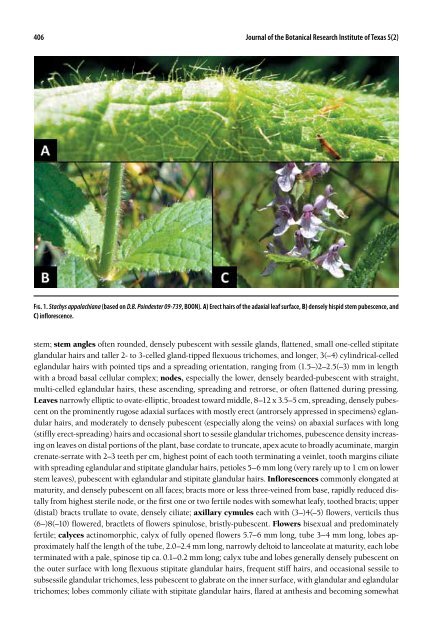Derick B. Poindexter John B. Nelson - Botanical Research Institute ...
Derick B. Poindexter John B. Nelson - Botanical Research Institute ...
Derick B. Poindexter John B. Nelson - Botanical Research Institute ...
Create successful ePaper yourself
Turn your PDF publications into a flip-book with our unique Google optimized e-Paper software.
406 Journal of the <strong>Botanical</strong> <strong>Research</strong> <strong>Institute</strong> of Texas 5(2)<br />
Fig. 1. Stachys appalachiana (based on D.B. <strong>Poindexter</strong> 09-739, BOON). A) Erect hairs of the adaxial leaf surface, B) densely hispid stem pubescence, and<br />
C) inflorescence.<br />
stem; stem angles often rounded, densely pubescent with sessile glands, flattened, small one-celled stipitate<br />
glandular hairs and taller 2- to 3-celled gland-tipped flexuous trichomes, and longer, 3(–4) cylindrical-celled<br />
eglandular hairs with pointed tips and a spreading orientation, ranging from (1.5–)2–2.5(–3) mm in length<br />
with a broad basal cellular complex; nodes, especially the lower, densely bearded-pubescent with straight,<br />
multi-celled eglandular hairs, these ascending, spreading and retrorse, or often flattened during pressing.<br />
Leaves narrowly elliptic to ovate-elliptic, broadest toward middle, 8–12 x 3.5–5 cm, spreading, densely pubescent<br />
on the prominently rugose adaxial surfaces with mostly erect (antrorsely appressed in specimens) eglandular<br />
hairs, and moderately to densely pubescent (especially along the veins) on abaxial surfaces with long<br />
(stiffly erect-spreading) hairs and occasional short to sessile glandular trichomes, pubescence density increasing<br />
on leaves on distal portions of the plant, base cordate to truncate, apex acute to broadly acuminate, margin<br />
crenate-serrate with 2–3 teeth per cm, highest point of each tooth terminating a veinlet, tooth margins ciliate<br />
with spreading eglandular and stipitate glandular hairs, petioles 5–6 mm long (very rarely up to 1 cm on lower<br />
stem leaves), pubescent with eglandular and stipitate glandular hairs. Inflorescences commonly elongated at<br />
maturity, and densely pubescent on all faces; bracts more or less three-veined from base, rapidly reduced distally<br />
from highest sterile node, or the first one or two fertile nodes with somewhat leafy, toothed bracts; upper<br />
(distal) bracts trullate to ovate, densely ciliate; axillary cymules each with (3–)4(–5) flowers, verticils thus<br />
(6–)8(–10) flowered, bractlets of flowers spinulose, bristly-pubescent. Flowers bisexual and predominately<br />
fertile; calyces actinomorphic, calyx of fully opened flowers 5.7–6 mm long, tube 3–4 mm long, lobes approximately<br />
half the length of the tube, 2.0–2.4 mm long, narrowly deltoid to lanceolate at maturity, each lobe<br />
terminated with a pale, spinose tip ca. 0.1–0.2 mm long; calyx tube and lobes generally densely pubescent on<br />
the outer surface with long flexuous stipitate glandular hairs, frequent stiff hairs, and occasional sessile to<br />
subsessile glandular trichomes, less pubescent to glabrate on the inner surface, with glandular and eglandular<br />
trichomes; lobes commonly ciliate with stipitate glandular hairs, flared at anthesis and becoming somewhat
















